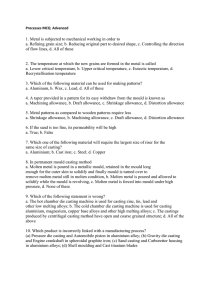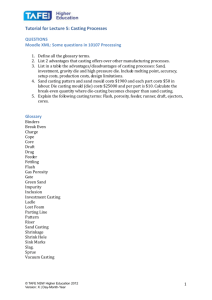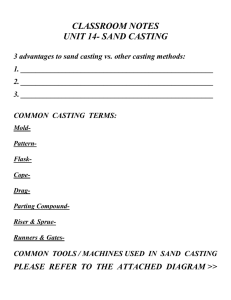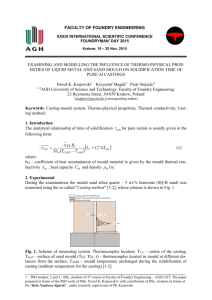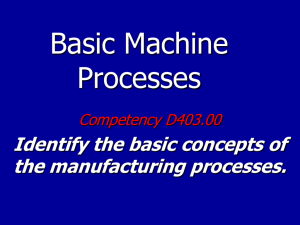FOUNDRY TECHNOLOGY (PATTERNS
advertisement
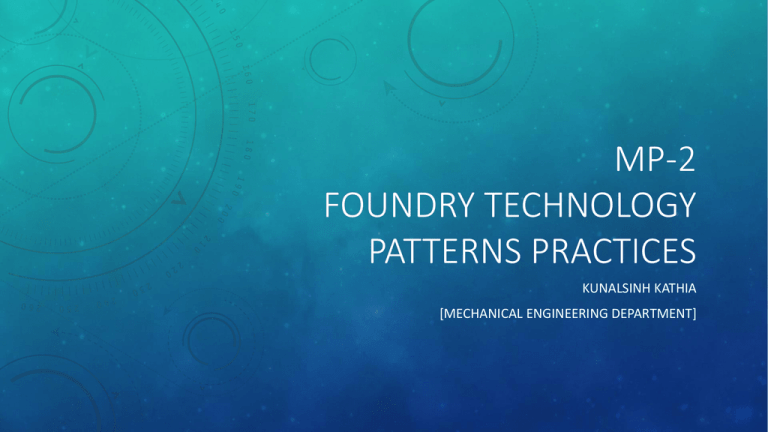
MP-2 FOUNDRY TECHNOLOGY PATTERNS PRACTICES KUNALSINH KATHIA [MECHANICAL ENGINEERING DEPARTMENT] PATTERN • A pattern is a model or the replica of the object (to be casted). It is embedded in molding sand • and suitable ramming of molding sand around the pattern is made. The pattern is then • withdrawn for generating cavity (known as mold) in molding sand. Thus it is a mould forming • tool. Pattern can be said as a model or the replica of the object to be cast except for the • various allowances a pattern exactly resembles the casting to be made. It may be defined as • a model or form around which sand is packed to give rise to a cavity known as mold cavity • in which when molten metal is poured, the result is the cast object. When this mould/cavity • is filled with molten metal, molten metal solidifies and produces a casting (product). So the • pattern is the replica of the casting. OBJECTIVES OF A PATTERN • 1 Pattern prepares a mould cavity for the purpose of making a casting. • 2 Pattern possesses core prints which produces seats in form of extra recess for core • placement in the mould. • 3 It establishes the parting line and parting surfaces in the mould. • 4 Runner, gates and riser may form a part of the pattern. • 5 Properly constructed patterns minimize overall cost of the casting. • 6 Pattern may help in establishing locating pins on the mould and therefore on the • casting with a purpose to check the casting dimensions. • 7 Properly made pattern having finished and smooth surface reduce casting defects. COMMON PATTERN MATERIALS • Wood • Shisham : It is dark brown in color having golden and dark brown stripes. It is very hard to work and blunts the cutting tool very soon during cutting. It is very strong and durable. • Kail: It has too many knots. It is available in Himalayas and yields a close grained, moderately hard and durable wood. It can be very well painted. • Deodar:It is white in color when soft but when hard, its color turns toward light yellow. It is strong and durable. It gives fragrance when smelled • Teak wood: It is hard, very costly and available in golden yellow or dark brown color. Special stripes on it add to its beauty. In India, it is found in M.P. It is very strong and durable and has wide • Mahongany: This is a hard and strong wood. Patterns made of this wood are more durable than those of above mentioned woods and they are less likely to warp. It has got a uniform straight grain structure and it can be easily fabricated in various shapes ADVANTAGES OF WOODEN PATTERNS • 1 Wood can be easily worked. • 2 It is light in weight. • 3 It is easily available. • 4 It is very cheap. • 5 It is easy to join. • 6 It is easy to obtain good surface finish. • 7 Wooden laminated patterns are strong. • 8 It can be easily repaired. DISADVANTAGES 1 It is susceptible to moisture. 2 It tends to warp. 3 It wears out quickly due to sand abrasion. 4 It is weaker than metallic patterns. METAL • These patterns are not affected by moisture and rust. • Metal is easier to shape and to finish. • Main disadvantages of this pattern is the higher cost, rust tendency to resist rust. CAST IRON • It is cheaper, stronger, tough, and durable and can produce a smooth surface finish. • It also possesses good resistance to sand abrasion. The drawbacks of cast iron patterns are that • they are hard, heavy, brittle and get rusted easily in presence of moisture. ADVANTAGES OF C.I • 1 It is cheap • 2. It is easy to file and fit • 3 It is strong • 4. It has good resistance against sand abrasion • 5. Good surface finish DISADVANTAGES OF C.I • 1 It is heavy • 2 It is brittle and hence it can be easily broken • 3 It may rust BRASSES AND BRONZES • Advantages: • 1. Better surface finish than cast iron. • 2. Very thin sections can be easily casted. Disadvantages: • 1. It is costly • 2. It is heavier than cast iron. ALUMINUM ALLOY • Aluminum alloy patterns are more popular and best among all the metallic patterns • because of their high light ness, good surface finish, low melting point and good strength. • They also possesses good resistance to corrosion and abrasion by sand and there by enhancing • longer life of pattern. These materials do not withstand against rough handling. ADVANTAGES OF ALUMINUM ALLOY • 1. Aluminum alloys pattern does not rust. • 2. They are easy to cast. • 3. They are light in weight. • 4. They can be easily machined. DISADVANTAGE OF ALUMINUM ALLOY • 1. They can be damaged by sharp edges. • 2. They are softer than brass and cast iron. • 3. Their storing and transportation needs proper care. WHITE METAL (ALLOY OF ANTIMONY, COPPER AND LEAD) • Advantages: • 1. It is best material for lining and stripping plates. • 2. It has low melting point around 260°C • 3. It can be cast into narrow cavities. • Disadvantages: • 1. It is too soft. • 2. Its storing and transportation needs proper care • 3. It wears away by sand or sharp edges. PLASTIC • Plastics are getting more popularity now a days because the patterns made of these materials • are lighter, stronger, moisture and wear resistant, non sticky to molding sand, durable and • they are not affected by the moisture of the molding sand. Moreover they impart very smooth • surface finish on the pattern surface. These materials are somewhat fragile, less resistant to • sudden loading and their section may need metal reinforcement. The plastics used for this • purpose are thermosetting resins. Phenolic resin plastics are commonly used. These are • originally in liquid form and get solidified when heated to a specified temperature. To prepare • a plastic pattern, a mould in two halves is prepared in plaster of paris with the help of a • wooden pattern known as a master pattern. The phenolic resin is poured into the mould and • the mould is subjected to heat. The resin solidifies giving the plastic pattern. Recently a new • material has stepped into the field of plastic which is known as foam plastic. Foam plastic is • now being produced in several forms and the most common is the expandable polystyrene • plastic category. It is made from benzene and ethyl benzene. PLASTER • This material belongs to gypsum family which can be easily cast and worked with wooden • tools and preferable for producing highly intricate casting. • The main advantages of plaster are that it has high compressive strength and is of high expansion setting type which compensate for the shrinkage allowance of the casting metal. • Plaster of paris pattern can be prepared either by directly pouring the slurry of plaster and water in moulds prepared earlier from a master pattern or by sweeping it into desired shape or form by the sweep and strickle method. It is also preferred for production of small size intricate castings and making core boxes. WAX • Patterns made from wax are excellent for investment casting process. • The materials used are blends of several types of waxes, and other additives which act as polymerizing agents,stabilizers, etc. • The commonly used waxes are paraffin wax, shellac wax, bees-wax, cerasin wax, and micro-crystalline wax. FACTORS EFFECTING SELECTION OF PATTERN MATERIAL • 1. Number of castings to be produced. Metal pattern are preferred when castings are • required large in number. • 2. Type of mould material used. • 3. Kind of molding process. • 4. Method of molding (hand or machine). • 5. Degree of dimensional accuracy and surface finish required. • 6. Minimum thickness required. • 7. Shape, complexity and size of casting. • 8. Cost of pattern and chances of repeat orders of the pattern. TYPES OF PATTERN • 1. One piece or solid pattern • 2. Two piece or split pattern • 3. Cope and drag pattern • 4. Three-piece or multi- piece pattern • 5. Loose piece pattern • 6. Match plate pattern • 7. Follow board pattern • 8. Gated pattern • 9. Sweep pattern • 10. Skeleton pattern • 11. Segmental or part pattern 1. SINGLE-PIECE OR SOLID PATTERN • Solid pattern is made of single piece without joints, partings • lines or loose pieces. It is the simplest form of the pattern. • Typical single piece pattern is shown in Fig. 2. TWO-PIECE OR SPLIT PATTERN • When solid pattern is difficult for withdrawal from the mold cavity, then solid pattern is splited in two parts. • Split pattern is made in two pieces which are joined at the parting line by means of dowel pins. • The splitting at the parting line is done to facilitate the withdrawal of the pattern. 3. COPE AND DRAG PATTERN • In this case, cope and drag part of the mould are prepared separately. • This is done when the complete mould is too heavy to be handled by one operator. • The pattern is made up of two halves, which are mounted on different plates. 4. THREE-PIECE OR MULTI-PIECE PATTERN • Some patterns are of complicated kind in shape and hence can not be made in one or two • pieces because of difficulty in withdrawing the pattern. Therefore these patterns are made in • either three pieces or in multi-pieces. Multi molding flasks are needed to make mold from • these patterns. 5. LOOSE-PIECE PATTERN • when pattern is difficult for withdrawl from the mould • Loose pieces are provided on the pattern and they are the part of pattern. • The main pattern is removed first leaving the loose piece portion of the pattern in the mould. Finally the loose piece is withdrawal separately leaving the intricate mould. 6. MATCH PLATE PATTERN • This pattern is made in two halves and is on mounted on the opposite sides of a wooden or • metallic plate, known as match plate. The gates and runners are also attached to the plate. • This pattern is used in machine molding. A typical example of match plate pattern is shown in Fig. 7. FOLLOW BOARD PATTERN • When the use of solid or split patterns becomes difficult, • a contour corresponding to the exact shape of one half • of the pattern is made in a wooden board, which is • called a follow board and it acts as a molding board for • the first molding operation as shown in Fig. 8. GATED PATTERN • In the mass production of casings, multi cavity moulds are used. Such moulds are formed by • joining a number of patterns and gates and providing a common runner for the molten metal, • as shown in Fig. 10.7. These patterns are made of metals, and metallic pieces to form gates • and runners are attached to the pattern. 9. SWEEP PATTERN • Sweep patterns are used for forming large circular moulds of symmetric kind by revolving a • sweep attached to a spindle as shown in Fig. 10.8. Actually a sweep is a template of wood or • metal and is attached to the spindle at one edge and the other edge has a contour depending • upon the desired shape of the mould. The pivot end is attached to a stake of metal in the • center of the mould. 10. SKELETON PATTERN • When only a small number of large and heavy • castings are to be made, it is not economical to • make a solid pattern. In such cases, however, • a skeleton pattern may be used. This is a ribbed • construction of wood which forms an outline of • the pattern to be made. This frame work is • filled with loam sand and rammed. The surplus • sand is removed by strickle board. For round • shapes, the pattern is made in two halves which • are joined with glue or by means of screws etc. • A typical skeleton pattern is shown in 11. SEGMENTAL PATTERN • Patterns of this type are generally used for • circular castings, for example wheel rim, gear • blank etc. Such patterns are sections of a • pattern so arranged as to form a complete • mould by being moved to form each section of • the mould. The movement of segmental pattern • is guided by the use of a central pivot. A • segment pattern for a wheel rim is shown in • Fig. PATTERN ALLOWANCES • Pattern may be made from wood or metal and its color may not be same as that of the • casting. The material of the pattern is not necessarily same as that of the casting. Pattern • carries an additional allowance to compensate for metal shrinkage. It carries additional • allowance for machining. It carries the necessary draft to enable its easy removal from the • sand mass. It carries distortions allowance also. Due to distortion allowance, the shape of • casting is opposite to pattern. Pattern may carry additional projections, called core prints to • produce seats or extra recess in mold for setting or adjustment or location for cores in mold • cavity. It may be in pieces (more than one piece) whereas casting is in one piece. Sharp • changes are not provided on the patterns. These are provided on the casting with the help • of machining. Surface finish may not be same as that of casting. DIFFERENT TYPE OF ALLOWANCES • Shrinkage allowance • Machining allowance. • Draft or Tapper allowance • Rapping or shake allowances • Distortion allowances • Mold wall movement allowance 1. SHRINKAGE ALLOWANCE • The total contraction in volume is divided into the following parts: • 1. Liquid contraction, i.e. the contraction during the period in which the temperature • of the liquid metal or alloy falls from the pouring temperature to the liquids • temperature. • 2. Contraction on cooling from the liquids to the solidus temperature, i.e. solidifying • contraction. • 3. Contraction that results there after until the temperature reaches the room • temperature. This is known as solid contraction. • The first two of the above are taken care of by proper gating and risering. Only the last • one, i.e. the solid contraction is taken care by the pattern makers by giving a positive • shrinkage allowance. 2. MACHINING ALLOWANCE • It is a positive allowance given to compensate for the amount of material that is lost in machining or finishing the casting. • If this allowance is not given, the casting will become undersize after machining. The amount of this allowance depends on the size of casting, methods of machining and the degree of finish. 3. DRAFT OR TAPER ALLOWANCE • Taper allowance is also a positive allowance and is given on all the vertical surfaces of pattern so that its withdrawal becomes easier.
